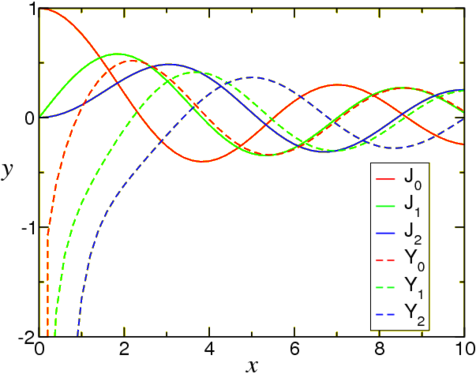10.2: Bessel’s Equation
( \newcommand{\kernel}{\mathrm{null}\,}\)
Bessel’s equation of order ν is given by x2y″+xy′+(x2−ν2)y=0. Clearly x=0 is a regular singular point, so we can solve by Frobenius’ method. The indicial equation is obtained from the lowest power after the substitution y=xγ, and is
γ2−ν2=0
So a generalized series solution gives two independent solutions if ν≠12n. Now let us solve the problem and explicitly substitute the power series,
y=xν∑nanxn.
From Bessel’s equation we find
∑n(n+ν)(n+ν−1)aνxm+ν+∑n(n+ν)aνxm+ν+∑n(x2−ν2)aν=0
which leads to
[(m+ν)2−ν2]am=−am−2 or am=−1m(m+2ν)am−2.
If we take ν=n>0, we have
am=−1m(m+2n)am−2.
This can be solved by iteration,
a2k=−141k(k+n)a2(k−1)=(14)21k(k−1)(k+n)(k+n−1)a2(k−2)=(−14)kn!k!(k+n)!a0.
If we choose1 a0=1n!2n we find the Bessel function of order n
Jn(x)=∞∑k=0(−1)kk!(k+n)!(x2)2k+n.
There is another second independent solution (which should have a logarithm in it) with goes to infinity at x=0.

Figure 10.2.1: A plot of the first three Bessel functions Jn and Yn.
The general solution of Bessel’s equation of order n is a linear combination of J and Y, y(x)=AJn(x)+BYn(x).
- This can be done since Bessel’s equation is linear, i.e., if g(x) is a solution Cg(x) is also a solution.↩


